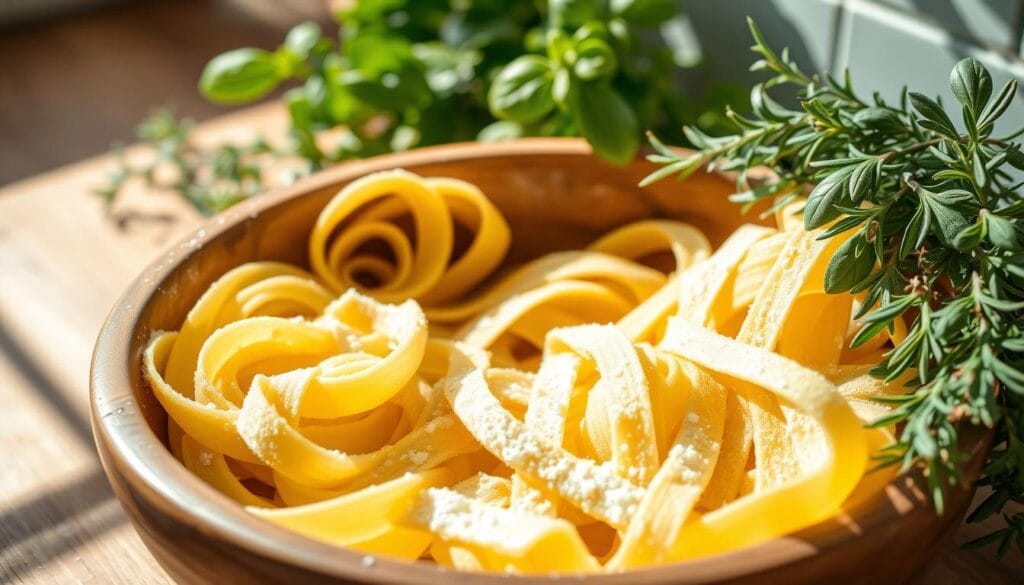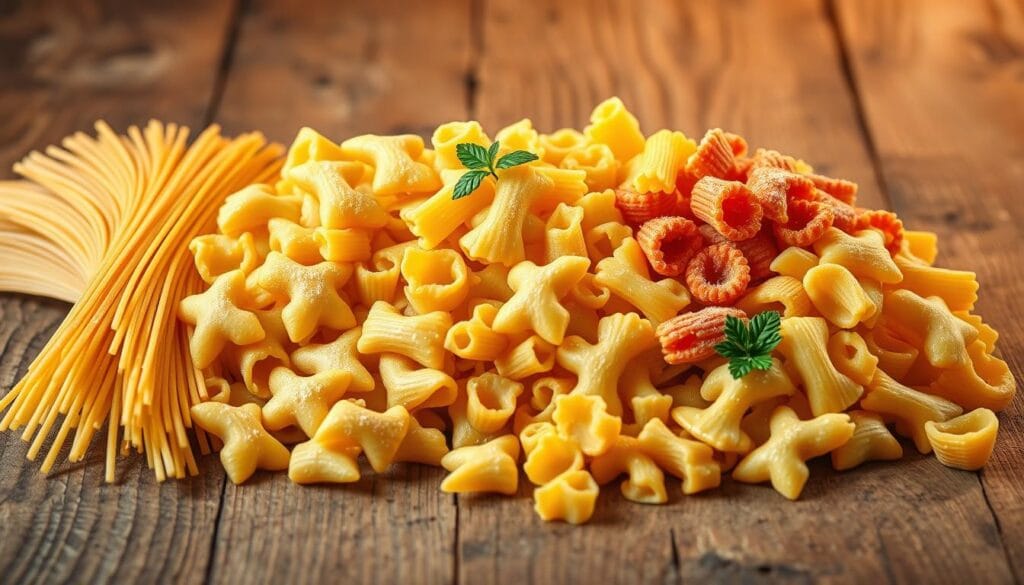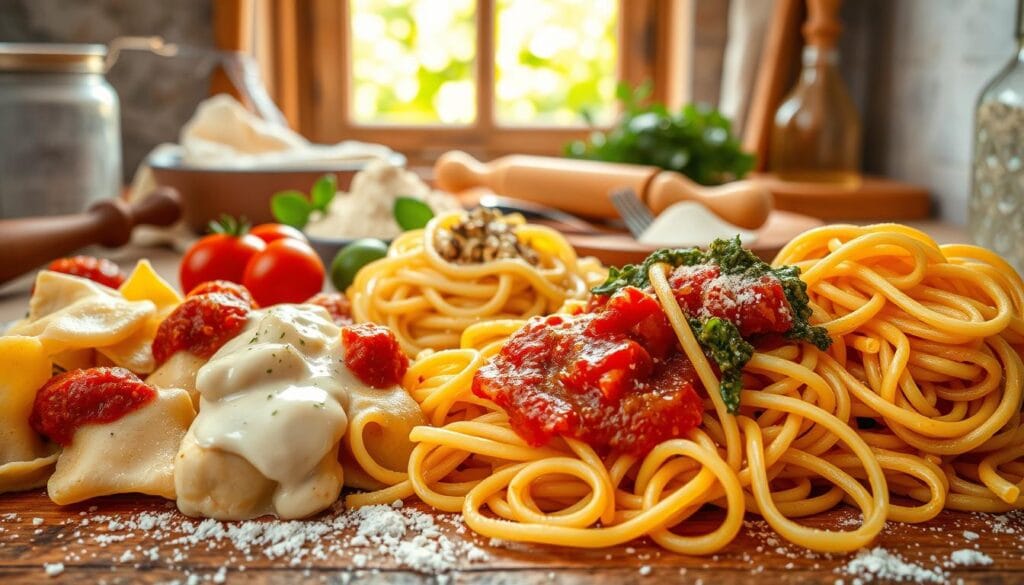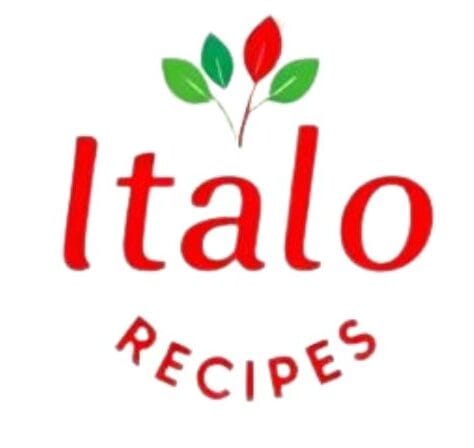Pasta fresca 24: Elevate Your Meals with Homemade Italian Pasta
Imagine enjoying a homemade Italian meal with fresh pasta. This pasta is made with love and care. Making pasta fresca at home lets you elevate any meal and enjoy a real Italian experience.
Making pasta fresca is easy and rewarding. It lets you choose the ingredients and quality. You can make many dishes, from spaghetti carbonara to creative recipes. It’s a great skill for cooks of all levels to impress others.

Introduction to Pasta Fresca
Exploring pasta fresca reveals its rich history and cultural value. You’ll learn about different flours and shaping techniques. With the right tools and ingredients, you can make delicious pasta fresca for your kitchen.
Table of Contents
The Rich Heritage of Pasta Fresca in Italian Cuisine
Italian pasta, especially authentic pasta, has a long history. It started in ancient China, but Italy made it a key part of their food. By the late Middle Ages, pasta was a big deal in Italy, especially in the south.
The Renaissance changed pasta from a luxury to a common food. Now, Italy makes and eats the most pasta in the world. The pasta industry is big for Italy’s economy, with brands like Barilla and De Cecco leading the way.
Every Italian region has its own pasta shapes and ways of making them. For example, Liguria has trofie, Puglia has orecchiette, and Lazio has bucatini. These dishes show the rich history of Italian pasta and its role in Italian food.
Essential Tools and Equipment for Making Fresh Pasta
To make your own pasta, you need the right tools. A pasta machine is key for rolling out dough to the right thickness. You can choose from manual or electric machines. Prices range from $80 to $120 for popular models like the Marcato Atlas 150 and the Imperia pasta maker.
When picking a pasta machine, look at how many settings it has and the dough thickness it can handle. The Marcato Atlas can roll dough to 0.5 millimeters, while the Imperia goes up to 0.9 millimeters. Think about the pasta recipes you want to make and what extra equipment you might need.
Other must-haves include a large dish for kneading, a sharp knife or cutter for shapes, and a colander for draining. With the right tools and a bit of practice, you’ll soon be making tasty pasta dishes. You can go from simple spaghetti to more complex recipes.
Also, consider a stand mixer attachment like the KitchenAid or GVODE. It makes rolling out dough faster and easier. These attachments are great for making fettuccine, tagliolini, and more.
Understanding the Perfect Ingredients for Pasta Fresca
When making homemade pasta, the quality of ingredients is key. To make the best fresh pasta, choose the right flour and eggs. You can also add optional ingredients for extra flavor.
The best flour for artisanal pasta is high in protein. This makes the pasta chewier.
Use about 2 ounces of fresh pasta per person. The flour you pick can change the pasta’s texture and taste. For example, high protein flours make thicker pasta chewier, like tagliatelle. Lower protein flours make pasta lighter and more delicate, perfect for ravioli.
Here are some key factors to consider when selecting ingredients for pasta fresca:
- Flour: High-protein flour is best for artisanal pasta
- Eggs: Fresh eggs are essential for binding the dough
- Optional ingredients: Herbs, spices, and other flavorings can be added to create unique flavors
Understanding the role of ingredients in homemade pasta lets you try new flavors and textures. Whether making fresh pasta or artisanal pasta, use quality ingredients and enjoy the process.
Basic Pasta Fresca Dough Recipe
To make a tasty Italian dish, start with a basic pasta fresca dough. Traditional recipes mix flour and eggs. For 5 people, use 500 g of Type ’00’ flour and 5 large eggs. Or, try 250 g of superfine flour with 250 g of durum wheat flour for a unique taste.
Getting the dough right is key. It should not stick to your fingers when it’s just right. Knead the dough for about 10 minutes. Then, let it rest for at least 30 minutes to relax the gluten.
Here’s a simple recipe to get you started:
- 500 g of Type ’00’ flour
- 5 large eggs
- Salt, to taste
You can also try different flour mixes, like 250 g of superfine flour and 250 g of durum wheat flour. For a classic pasta, use 1 egg for every 100 grams of flour.
Once you get the hang of the basic dough, you can try different shapes. Like fettuccine or tagliolini. With practice, your pasta dishes will be filled with traditional flavors.
Step-by-Step Pasta Making Techniques
To make tasty artisanal pasta, you must learn how to make fresh pasta. This means mixing and kneading the dough, rolling it out, and shaping it. With practice, you can make your homemade pasta just like a pro and enjoy it with your favorite sauces.
When making fresh pasta, using the right ingredients is key. Start by mixing 1½ cups of all-purpose flour with 2 large eggs. You can also add nutmeg, salt, and black pepper for extra flavor.
After mixing and kneading, roll out the dough to the right thickness. This step is important for the right texture. Use a pasta roller to get it just right, a bit thicker than tagliatelle before shaping.
Some important tips for making fresh pasta include:
- Rest the dough for at least 10 minutes to relax the gluten
- Knead the dough for 5 to 10 minutes until it’s smooth
- Roll out the dough to the right thickness, thin but not too thin
- Shape the pasta into different forms, like garganelli or tagliatelle
By following these steps and tips, you can make delicious artisanal pasta that will wow your friends and family. Whether you’re new to pasta making or have experience, the secret to success is mastering the techniques of making fresh pasta. Don’t be afraid to try new ingredients and flavors to create your own special recipes.
Common Shapes and Forms of Fresh Pasta
Italian pasta comes in many shapes and forms. Italy produces and eats about 300 types of pasta. Fresh pasta offers a wide range, from long strands like spaghetti to short, detailed shapes like ravioli and tortellini.
Long fresh pasta formats include tagliatelle, pappardelle, and capellini. These are great with light, oily sauces. Short shapes like orecchiette and gnocchi work well with hearty, chunky sauces.
Here are some popular types of fresh pasta:
- Tagliatelle: a long, flat shape typically 7 mm wide
- Fettuccine: a long, flat shape ranging from 3-5 mm in width
- Ravioli: a stuffed shape that can be filled with meat, cheese, or vegetables
- Tortellini: a ring-shaped pasta typically filled with meat or cheese

Looking for a classic pasta dish like spaghetti carbonara or something adventurous like authentic pasta with game sauce? There’s a fresh pasta type for you. Fresh pasta is a big part of Italian cuisine. It’s a staple in many Italian homes. So, why not try it and explore the world of Italian pasta?
Troubleshooting Your Pasta Making Process
Starting to make homemade pasta can bring up some common problems. These issues can affect how good your pasta recipes taste. We’ve got some useful tips and advice to help you make your fresh pasta perfect every time.
Getting the dough right is key when making homemade pasta. If it’s too dry, it’s hard to work with and might not taste great. If it’s too wet, it can stick and tear easily. Aim for a dough that’s 55-57% water to get it just right.
Here are some common problems you might face when making fresh pasta, along with some tips to fix them:
- Fixing dough consistency issues: Adjust the hydration level by adding more water or flour as needed.
- Addressing common mistakes: Pay attention to kneading time, resting time, and cooking time to ensure your pasta recipes turn out perfectly.
- Storage solutions: Store your homemade pasta in an airtight container to keep it fresh for a longer period.
By following these tips and advice, you’ll be well on your way to making delicious homemade pasta. Use the best ingredients and pay attention to the details. Soon, you’ll be enjoying perfect fresh pasta with your family and friends.
Pairing Your Fresh Pasta with Sauces
The sauce is key to a great pasta dish. For Italian pasta, the right sauce can make the flavors pop. Fresh pasta needs a sauce that complements its eggy taste and chewy texture.
Artisanal pasta makers suggest light, delicate sauces for fresh pasta. Cream-based sauces like carbonara or Alfredo work well. Regional sauces, such as pesto or arrabbiata, add a special touch to pasta dishes.
Here are some popular sauce pairings for fresh pasta:
- Carbonara: a rich and creamy sauce made with eggs, parmesan, and guanciale
- Pesto: a classic Genovese sauce made with basil, garlic, and olive oil
- Arrabbiata: a spicy tomato sauce made with crushed tomatoes and red pepper flakes
Think about the pasta’s texture and flavor when choosing a sauce. Soft pasta shapes go well with creamy sauces. Thicker pasta shapes are better with tomato or meat-based sauces.

Try different sauce pairings to make a variety of tasty pasta dishes. This way, you can highlight the unique flavors and textures of fresh, Italian pasta and artisanal pasta.
Tips for Cooking Perfect Pasta Fresca
When cooking homemade pasta, getting the right texture is key. You need to watch the water temperature, cooking time, and how you drain it. For fresh pasta, use 2.5 quarts of water for every 400 grams of pasta. Also, add 1.5 tablespoons of plain salt for every 400 grams.
Cooking times vary by pasta type. For instance, fresh pappardelle cooks in 2-3 minutes, while orecchiette takes 3-4 minutes. Before draining, save about 1 cup of pasta water. This water can make your sauce creamy and flavorful.
Here are some tips for cooking fresh pasta:
- Cook in a large pot with plenty of water to prevent sticking
- Use a timer to ensure the pasta is cooked for the right amount of time
- Drain the pasta immediately after cooking and add it to your favorite sauce
By following these tips, you’ll make delicious homemade pasta dishes. These dishes will impress your friends and family. Always use the best ingredients and pay attention to details for the best results.
Advanced Techniques for Artisanal Pasta Making
As you get better at making pasta, you can try new things. You can make colored and flavored pasta to add something special to your pasta recipes.
Some cool ways to make artisanal pasta include:
- Creating stuffed pasta like ravioli or tortellini
- Making special shapes, like farfalle or pappardelle
- Using herbs or spices for unique flavors
Learning these advanced techniques lets you make many Italian pasta dishes. These dishes will wow your friends and family. No matter your skill level, there’s always more to learn in artisanal pasta making.
Conclusion: Mastering the Art of Homemade Pasta
Making homemade pasta or pasta fresca is a rewarding journey. It combines tradition, technique, and creativity. By improving your skills and trying new recipes, you can become a true pasta artisan.
The secret to great pasta fresca is using high-quality ingredients and precise methods. Keep exploring different recipes and techniques. With time and effort, you’ll make meals that wow your loved ones.
Embrace the art of pasta making and celebrate Italian cuisine. Let your journey with pasta fresca inspire and delight you. Buon appetito!


Laisser un commentaire